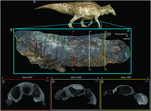
Dinosaur mummies are exceptionally preserved dinosaur fossils with skin traces covering substantial parts of the body. The term was coined by Henry Fairfield Osborn in 1911 for an Edmontosaurus specimen (AMNH 5060) discovered in 1908 by fossil hunter Charles Hazelius Sternberg and his three sons in Wyoming. A handful of similar dinosaur mummies has been found since. These include two Edmontosaurus specimens subsequently discovered by the Sternberg family, one of which (SMF R 4036) was sold to Germany, while the other was lost during World War I when it was shipped to England and the ship was sunk. Barnum Brown, in 1912, discovered a mummy he described as a new genus, Corythosaurus. In 1999, another Edmontosaurus mummy nicknamed "Dakota" was discovered, and in 2000, a Brachylophosaurus mummy was nicknamed "Leonardo".
The term "mummy" has, in the context of dinosaurs, only been used informally. All dinosaur fossils that have been regularly called "mummies" were found in North America and belong to the Hadrosauridae ("duck-billed dinosaurs"), and are therefore also known as "hadrosaur mummies". Occasionally, the name "mummy" has also been used for other exceptionally preserved dinosaur fossils such as the type specimen of Borealopelta and the Fighting Dinosaurs specimen.
Osborn noted that the skin of the first Edmontosaurus mummy was tightly wrapped around the specimen and partially drawn into the body interior. This indicates that the carcass had dried out and deflated before burial; the specimen is therefore the fossil of a natural mummy. It is now understood that not all specimens that are known as dinosaur "mummies" are necessarily mummified, and that other processes, including rapid burial and the absence of oxygen, may also lead to the preservation of such specimens.



 Detailed and labelled photographs of the preserved soft tissue of the mummy Dakota
Detailed and labelled photographs of the preserved soft tissue of the mummy Dakota
Skin is typically preserved only in the form of impressions that the original skin left in the sediments that were encasing the specimen. In contrast, the "Dakota" specimen still preserves the original skin three-dimensionally, including biomarkers. This specimen also preserves skin injuries inflicted by scavengers (possibly crocodyliforms or theropods), the first such record documented in dinosaurs. Other soft tissues and traces may be preserved, including the skin frill that ran along the back of the animals; nostrils; ossified tendons; the horny beak; and stomach contents.
Dinosaur mummies had a significant impact on the scientific and popular perception of hadrosaurids, and dinosaurs in general. Skin impressions found in between the fingers of the first two mummies have originally been interpreted as interdigital webbing, bolstering the now-rejected perception of hadrosaurids as aquatic animals, a hypothesis that remained unchallenged until 1964. Gregory S. Paul, in 1987, stated that the life appearance of Edmontosaurus and Corythosaurus can be more accurately restored than that of any other dinosaur thanks to the well-preserved mummy specimens.
References
- ^ Carpenter, Kenneth (2007). "How to make a fossil: Part 2 – Dinosaur Mummies and other soft tissue". The Journal of Paleontological Science: 5–14.
- ^ Drumheller, Stephanie K.; Boyd, Clint A.; Barnes, Becky MS; Householder, Mindy L. (2022). "Biostratinomic alterations of an Edmontosaurus "mummy" reveal a pathway for soft tissue preservation without invoking "exceptional conditions"". PLOS ONE. 17 (10): –0275240. Bibcode:2022PLoSO..1775240D. doi:10.1371/journal.pone.0275240. PMC 9555629. PMID 36223345.
- Joubarne, Tristan; Therrien, François; Zelenitsky, Darla K. (2022-12-14). "Integumentary impressions on hadrosaurid specimens from the Upper Cretaceous (upper Campanian) Dinosaur Park Formation, Alberta, Canada: implications for integument patterns and hand morphology". Journal of Vertebrate Paleontology. 42 (6): –2213287. doi:10.1080/02724634.2023.2213287. ISSN 0272-4634. S2CID 259402283.
- Osborn, Henry Fairfield (1911). "A Dinosaur Mummy". The American Museum Journal. 11. New York, NY: 7–11.
- ^ Manning, Phillip Lars (2008). "Chapter four: Dinosaur Mummies". Grave Secrets of Dinosaurs: Soft Tissues and Hard Science. Washington, D.C.: National Geographic. ISBN 978-1426202193.
- Schweitzer, Mary Higby (2011). "Soft tissue preservation in terrestrial mesozoic vertebrates". Annual Review of Earth and Planetary Sciences. 39 (1): 187–216. Bibcode:2011AREPS..39..187S. doi:10.1146/annurev-earth-040610-133502.
- Osborn, Henry Fairfield (1912). "Integument of the iguanodont dinosaur Trachodon". Memoirs of the American Museum of Natural History. 1: 33–35, 46–54.
- ^ Prieto-Márquez, Albert; Wagner, Jonathan R. (2015). "Soft-tissue structures of the nasal vestibular region of saurolophine hadrosaurids (Dinosauria, Ornithopoda) revealed in a "mummified" specimen of Edmontosaurus annectens". In Eberth, David A.; Evans, David C. (eds.). Hadrosaurs. Bloomington and Indianapolis: Indiana University Press. pp. 591–599. ISBN 978-0-253-01385-9.
- Forster, Catherine A. (1997). "Hadrosauridae". In Currie, Philip J.; Padian, Kevin (eds.). Encyclopedia of Dinosaurs. San Diego, CA: Academic Press. pp. 294, 297. ISBN 978-0122268106.
- Paul, Gregory S. (1987). "The science and art of restoring the life appearance of dinosaurs and their relatives; a rigorous how-to guide". In Czerkas, S.J.; Olson, E.C. (eds.). Dinosaurs, Past and Present. 2. University of Washington Press. pp. 40–42. ISBN 978-0-295-96570-3.